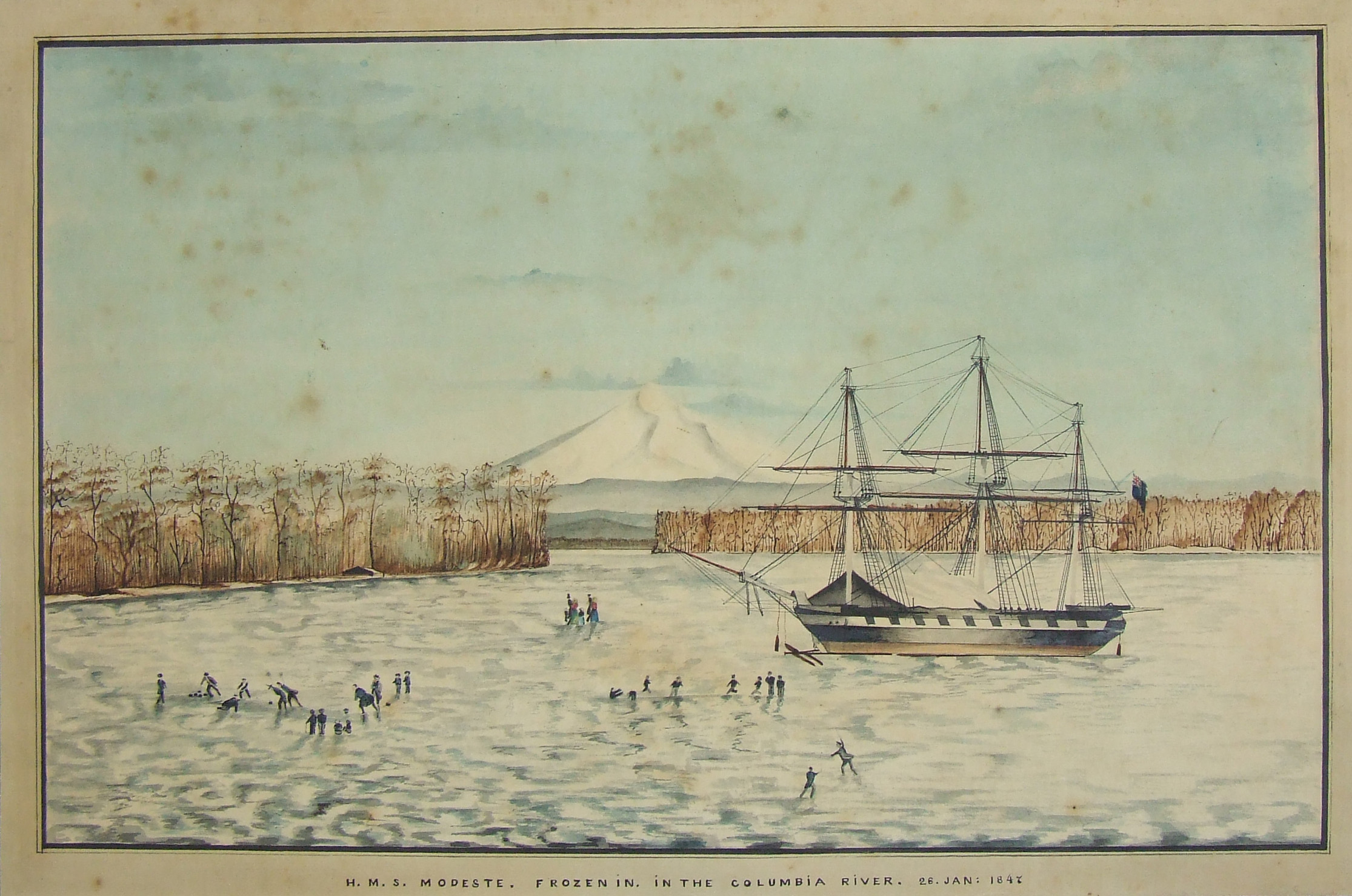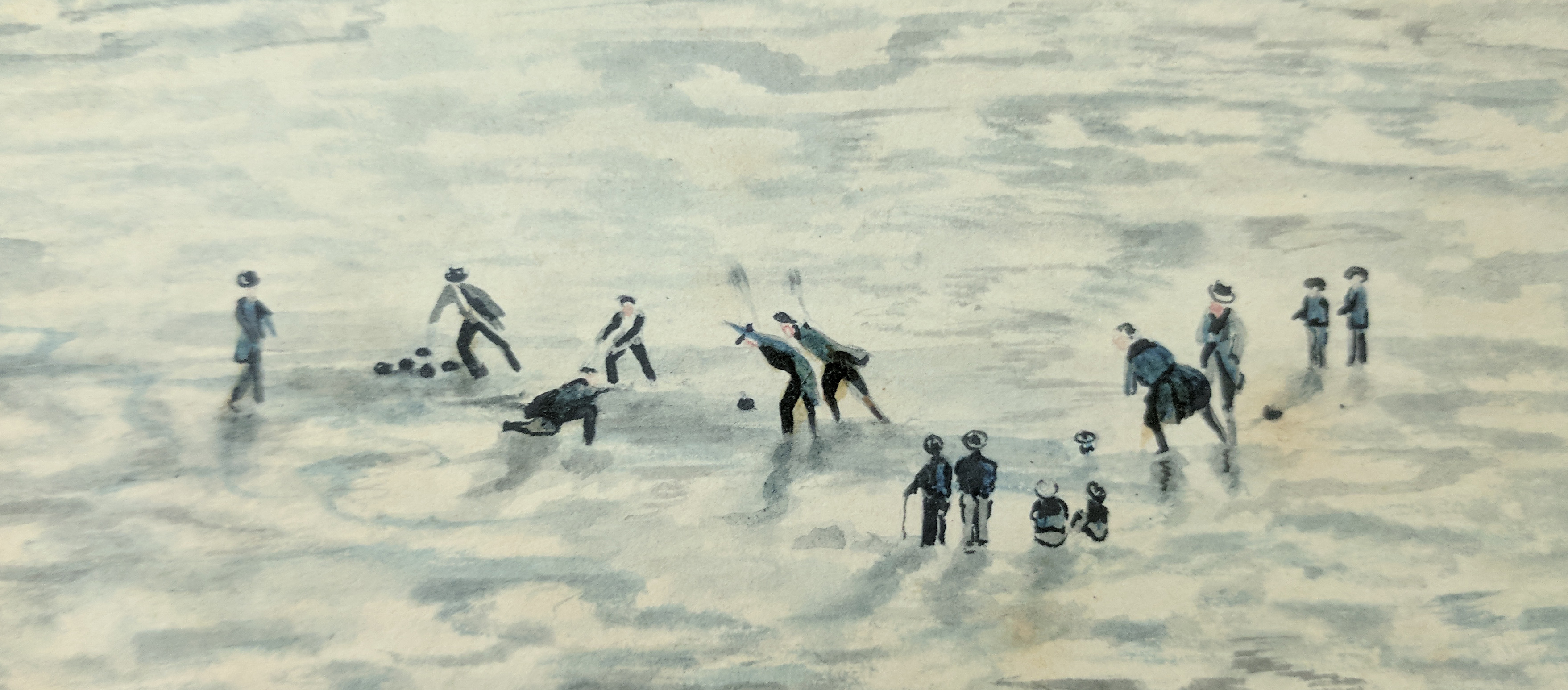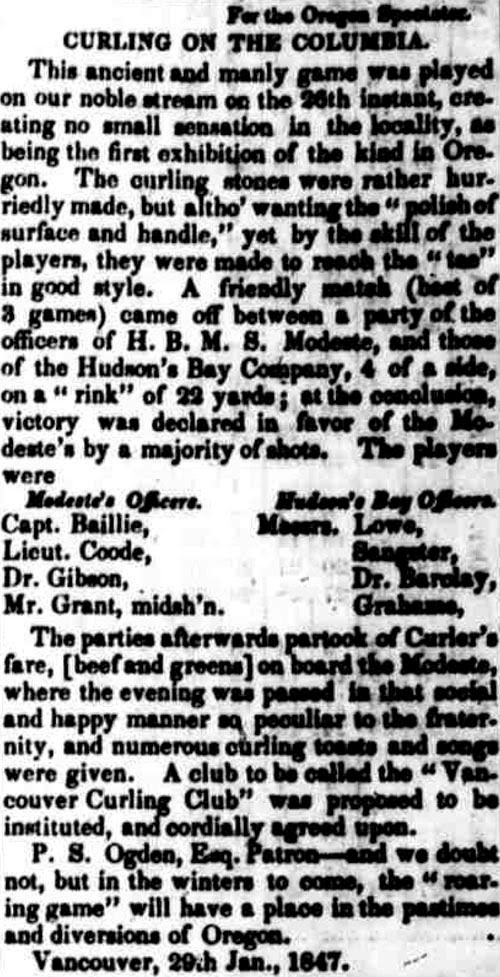While researching George Vancouver I ran across a very interesting watercolor in the collection that obviously documents a very specific event but the computer didn’t contain any information on what it might be. Whenever that happens I usually hit the Internet because 9 times out of 10 someone out there has already written or researched the event and there’s no point reinventing the wheel if I don’t have to!
The watercolor shows the HMS Modeste frozen in the Columbia River on January 26, 1847. There are people on the ice all around the ship, some are just walking and others look like they are fencing, skating or just having fun, but there is one particular group of individuals that seems to be doing something pretty specific—something important enough that the artist felt the need to document the event and the date it occurred.

As it turns out, the event was the very first curling match held in Pacific Northwest. You guys know what curling is right? It’s that rather odd sport that involves giant stones sliding down a sheet of ice (like a bowling alley) with the team members racing in front of it with brooms to make the ice slicker (or something to that effect—I don’t pretend to be any sort of expert on curling so I am not really sure why the brooms are involved—although they’d make great weapons in the event of some sort of disagreement!).
The history behind the event turns out to be VERY interesting! I culled most of this information from curlinghistory.blogspot.com where Bob Cowan discussed how Royal Navy personnel introduced the sport of curling into the Pacific Northwest in 1847. I’ll post the link below so you can read the whole story.
In November 1845 HMS Modeste traveled about 100 miles up the Columbia River and anchored off Fort Vancouver, an outpost of the Hudson’s Bay Company. The impetus for Modeste’s visit was president James K. Polk’s claim that the northwest coast of North America belonged to the United States. In 1819 the two countries had agreed to a joint occupation of the area so Polk’s sudden claim placed Britain and the United States in direct conflict. As a way of indicating that Great Britain would not give up the Pacific Northwest without a fight the Admiralty sent Modeste to Fort Vancouver.
By June of 1846 a compromise had been reached but Modeste remained anchored off Fort Vancouver to ensure the compromise was accepted and maintained. The weather was so severe the following winter the Columbia River froze over. While icebound, the captain and officers of Modeste organized events and contests aimed at keeping relations between the two countries cordial and the morale of the ship’s crew high. The ship’s log documents Modeste’s crew putting on several plays; holding a ball; conducting horse races; and apparently the ship’s surgeon, John Gibson, organized a curling match.
Gibson documented the event in a letter to the Secretary of the Royal Caledonian Curling Club in Edinburgh.
“HER MAJESTY’S SHIP MODESTE:
Columbia River, 27th January 1847
Dear Sir,
Knowing the interest which you take in the prosperity of our manly game, at home, as well as in foreign lands, I beg to acquaint you, that in this the Far West, upon the noble river Columbia, a friendly Match was yesterday played (the first in Oregon) between a party of the Officers of HMS Modeste, now frozen in, and of the Honourable the Hudson’s Bay Company’s Officers.”
In his letter Gibson explains how one of the ship’s marines helped procure suitable stones they could play with, describes the creation of a rink 32 yards in length and the ensuing series of three games. The teams included Captain Thomas Baillie, Lieutenant Trevenen Penrose Coode, surgeon John Gibson, and a midshipman named Grant representing the HMS Modeste and Dr. Forbes Barclay, and Messrs. Lowe, Sangster, and Grahame representing the Hudson’s Bay Company. The Modeste team won the first match, the Hudson’s Bay team won the second and Modeste finished the series by winning the third.

Gibson describes the matches with these words: “The ice was roughish, with occasional snow showers, but the sooping being well attended to, I assure you that shots were taken by some of the parties, sons of ‘keen keen curlers’ at home, that would be no disgrace to our crack clubs.”
The games were considered a great success and afterwards, the participants dined on board the Modeste with the traditional curlers’ fare of ‘beef and greens’. The event was so successful that plans were laid for the formation of a curling club in Vancouver and a report of the curling matches even appeared in the Oregon Spectator.

Unfortunately the artist hasn’t signed the image but it is amateurish enough that I really believe it was painted by one of the ship’s crew. Interestingly I was able to determine that one of the participants in the curling match, Lieutenant Coode, was also said to have created a few watercolors of Ft. Vancouver area during the ship’s visit (although I have only found one image so far that has been firmly attributed to him) so my bet is on him as the artist.
http://curlinghistory.blogspot.com/2014/08/naval-surgeon-john-gibson-and-curling.html